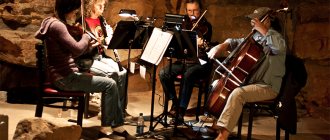“God forbid we see a Russian revolt, senseless and merciless!” — wrote A.S. Pushkin. This very accurately reflects the properties of such a powerful phenomenon as a crowd. If you have been to public events, concerts, parades, you know this feeling in the crowd. You seem to see individual people around you, but at the same time you feel like you are part of something big and united.
Surely you know the difference between coming to places of military glory with your family and going in the crowd on May 9th. In a crowd, emotions are brighter, experiences are stronger. And if people shout out an exciting “hurray!”, you feel how it all resonates inside you. Being in a crowd, a person becomes part of a large, unified process. And then you act according to these processes, because you are also now a crowd. It is almost impossible to resist this.
In this article:
The crowd as a single organismFormation of the crowdProperties of the crowdWho is attracted by the crowdClassification of the crowd
The crowd is like a single organism
Photo by Katie Rodriguez on Unsplash
The crowd lives as an integral organism, with its own properties, rhythm and strength. The main difference between the behavior of a crowd and one person is controllability. It’s easier to persuade one person to do something, to subjugate him. It is extremely difficult to control a crowd. The crowd is controlled by emotions, by its energy.
And she obeys only a bright, strong leader who is able to pick up the emotional wave of the crowd and lead her in the right direction. Here it is worth distinguishing between an army of soldiers subordinate to a commander and a crowd. Soldiers obey orders and are within a certain hierarchy and organizational framework.
The crowd, on the contrary, has no structure or organization; it is spontaneous. And it reacts only to emotional, powerful influence. The crowd is formed under the influence of unconscious processes - this is its main difference. People in a crowd are not connected to each other by relationships, they are connected by a common idea, and this connection exists in the background, people are not aware of it. A certain emotional excitement arises and the crowd acts spontaneously, without realizing a clear goal. For example, there were riots.
Crowd Psychology
For example, the story of Emelyan Pugachev. It all started with the idea of a better life for the peasants. It was by promising it that Emelyan achieved recognition as a leader. And then this huge movement was picked up by emotions of rebellion, protest and anger. People robbed civilians, and atrocities eventually fell on ordinary peasants. Is this what Pugachev wanted? Was this what he promised to the common people? It seems that this was not part of his plans. But under the idea of freedom and a better life, a huge crowd gathered, becoming a whole organism.
And this powerful monster was not driven by the best human feelings. Therefore, this resulted in cruelty and destruction, and aimless ones at that.
Behavior in a crowd
The basic rule of a person’s behavior in a crowd for his own salvation is the desire to preserve individuality.
The main thing is that a person in a crowd should not succumb to general psychosis, and should not turn into an ordinary member of the crowd maintaining mental tension. It is necessary to abstract from emotions, leaving only the mind. He alone is the only hope for salvation. Only he is able to show a person the correct behavioral strategy. Emotions lead a person to where everyone else will follow him.
Do you need proofreading or review of academic work? Ask a question to the teacher and get an answer in 15 minutes! Ask a Question
To avoid panic, you cannot take rumors for granted; you need to verify all information with facts.
You cannot blindly submit to the opinion of the crowd, no matter how correct it may seem at the moment.
Violent mass feelings - fear, hatred or joy - are extremely contagious. Mass psychosis must be resisted.
The main thing in everything is to maintain a clear, sober mind. You can use techniques from auto-training: breathe deeply, contemplate stationary objects, talk to yourself, etc.
You need to focus on the people close to you. The main task is to protect them. And this is only possible if you control the situation and your own mental state. Based on experience, we can say that under the influence of a crowd, social ties are destroyed, a person gives up caring for his friends and family, ceasing to notice them. The man of the crowd begins to quarrel with his loved ones. There are known cases when, during an attack of panic or a demonstration of fanatical devotion to the leader of the pack, that is, the leader of the crowd, mothers began to sacrifice their children.
Crowd Formation
The crowd begins by forming a core. Despite the fact that a crowd is a spontaneous phenomenon, the core is often formed through conscious processes. As a rule, these are the instigators of some process. This is a small number of people united by one goal and idea. Driven by this idea, they gather “supporters.”
The crowd is growing spontaneously and uncontrollably. It is not only supporters of the ideas of the instigators who join it. This usually happens after some event or action that attracts attention. People are drawn to curiosity and interest. And powerful energy also holds the infection in the crowd.
Each individual person emotionally joins the general process and a circular reaction begins. All members of the crowd are charged with similar emotions and a new mental interaction is born.
Emotions intensify and a single organism - the crowd - is ready to react to external events. Thus begins the second stage of crowd formation - circling. Emotions intensify within the crowd, they seem to be “circling”, and excitement increases.
In the process of circling and intensifying emotions, a certain general image is created, towards which all the feelings and impulses of the crowd are directed. Thus begins the third stage of crowd formation. She chooses the object of response. Feelings, thoughts and topics of discussion in the crowd are projected onto it. The Tola becomes united, driven by a common image and thoughts.
Giphy
The next stage of crowd formation is the activation of the internal impulses of each person, the intensification of emotions and the beginning of specific actions. As a rule, impulses are strengthened by the leader of the crowd or the core of instigators. Emotions “sway” and the crowd can only be directed towards the chosen object.
The crowd moves as a single, spontaneous organism. And this movement, based on strong emotions, cannot be stopped.
Crowd concept
Definition 1
A crowd is a large concentration of people in any territory who have direct contact and spontaneously react in a similar way to the same stimuli.
The crowd is characterized by primitive but strong emotions and impulses and has no established moral standards or taboos.
The crowd can be aggressive, running away, hungry, demonstrating.
Common phenomena are characteristic of different crowds:
- disappearance of individual personality traits, tendency to imitate;
- weakening of ethical and legal norms as a result of a sense of standardization;
- feeling that the actions they are taking are correct;
- decreased sense of responsibility for actions taken, a sense of one’s own strength.
Finished works on a similar topic
- Coursework Characteristics and examples of the crowd 420 rub.
- Abstract Characteristics and examples of the crowd 270 rub.
- Test work Characteristics and examples of the crowd 190 rub.
Receive completed work or specialist advice on your educational project Find out the cost
A person, finding himself in a crowd, receives a strong emotional impact, receives increased excitability in relation to his social feelings, so a random word thrown into the crowd can become an impetus for violence and pogroms.
The crowd has a transient influence on the individual, but the mood that arose in him can persist for a long time.
The connection that unites the crowd will be destroyed if new stimuli create other emotions - the instinct of self-preservation helps to disperse the crowd, a feeling of hunger, humor, excitement, directed towards other goals.
The techniques used to manipulate the crowd are based on knowledge of special mechanisms that unite the crowd.
The crowd can consist of individuals of any nationality, gender, profession and does not depend on the reasons for this meeting.
The “man of the crowd” is characterized by new features that differ from other individuals. These separate new features form a whole and take the same direction, and the conscious personality disappears. A kind of “collective soul” is formed, with a temporary nature, but constituting a single being and subject to the law of spiritual unity of the crowd. For a crowd to become organized, the accumulation of random individuals is not enough; the influence of certain pathogens is also necessary.
Need advice on your academic work? Ask a question to the teacher and get an answer in 15 minutes! Ask a Question
A crowd can form on the street due to a variety of events, and the elements, as the main background of the crowd’s behavior, can lead it to aggressive forms. When a person appears capable of leading it, then pockets of organization appear, but they are unstable.
French psychologist S. Mokovich believes that the masses are a social phenomenon; under the influence of the leader’s suggestions, individuals “dissolve” and the social machine makes them irrational.
Irritated people, gathered together, cannot control their impulses. The energy of emotions gives courage and propels us forward. Leaders use the energy of the masses for their own purposes. The mass is a more stable formation, more organized and conscious, although heterogeneous and unstable. Organizers en masse come forward in advance and have greater significance.
Crowd Properties
There is an infection mechanism at work in the crowd. This works in the same way as physical infection. A person can become “infected” even with thoughts and ideas that are alien to him while in a crowd. Infection can be stronger than the will of an individual. But the mechanism itself is not fully understood. Infection can be spread from one person to dozens of others, not just from one to another.
In a crowd, individual rational control is switched off. Logic and reason are powerless against the raging energy of the crowd. When witches were burned en masse, or Christians were burned during persecution, not all people in the crowd were ardent supporters of these movements. But the single spirit of the crowd, rage and struggle captured the man’s mind, and he, too, threw sticks into the fire. After the incident, a person may “wake up” and experience regret and shame about what he did. But in the process, in the crowd, everything personal is turned off.
The crowd has no capacity for awareness. Also, the crowd is influenced by images, emotions, it has a strong imagination. There can be several images that are not related to each other. If we consider the crowd as a living organism, then this is a child, and hyperactive and disinhibited: he is not aware of his actions and their consequences, he thinks in images, driven by desires and impulses, and has a high level of energy. The crowd reacts only to orders and promises.
The crowd is integrative. There is always something that unites these people. Managers use this property when conducting a planning meeting, for example. The team is charged with energy, general mood, and ideas. This is how individual employees become a team.
The crowd is categorical and suggestible, diffuse and irresponsible.
Photo by William White on Unsplash
It is very difficult not to blend in with the crowd; for this it is important to remember the purpose of your coming here - to work, to a concert or a rally. Remember why you are here and this will keep you from getting caught up in the crowd.
Who is attracted to the crowd?
The core of the crowd is formed from people captured by a common idea and goal. But very different people join them and for different reasons. The most explosive type of people are aggressive ones. The crowd attracts them with their ability to drain negativity, openly express aggression, hostility and sadistic tendencies. This is what you need in a crowd. And it is precisely this category of people that is the most uncontrollable.
Another category is those seeking justice. These are people driven by the idea of searching for justice in the world and who believe in any “crooked” ideas. They are easily gullible because they really need the feeling of retribution and the triumph of good. The tasks of the crowd “fall” very well on their psychological traumas. Although, they may not even fully understand what they are going into and what they are signing up for.
Common people. They are attracted by idle curiosity; out of boredom they are not averse to looking at an impressive spectacle. They are not going to be active themselves.
Suggestible people. A person of this mental type very easily succumbs to the mood and influence of the crowd, he is easily led, you just have to pick him up and he is already part of the crowd.
How to control a crowd
“A person should strain his mind even less: he just needs to look through and read the shortest texts,” Hitler wrote. Words evoke mental images, but also powerful visual images. At first there was an increase in the expressiveness of words due to radio, then the generation of images due to cinema and television.
The means of communication have undergone evolution. And first of all, unwanted people should be removed from television. And there are even fewer radio listeners and reading public. The means of communication have made automatic thinking a historical factor. And this factor will exist as long as the crowd exists.
In order to control a crowd you need a leader or a leader. But how should a leader inspire confidence in order to move the crowd and assert his influence over it? Litvak wrote that two paths are closed to the Leader: strength and reason. I completely agree with him, since force guarantees submission through fear, the mind is also not suitable, because the masses are insensitive to rational evidence. All that remains is seduction or seduction. It's like hypnosis, it takes the crowd away from its reality, more beautiful, corresponding to its hopes. The leader’s temptation is not to try to hide himself, but rather acts openly.
And to seduce in this way means to transfer the crowd from the rational world to the world of illusions.
Most likely you will think that leaders or leaders are deceivers. In fact, they themselves are in the grip of this illusion.
It is necessary for a leader to be like an actor. First of all, it is necessary to turn individuals into a crowd and involve them in certain activities. Scientists point out that techniques are always specific, but three strategies are always the same: presentation - controls space, ceremony - controls time, and persuasion - controls words.
In order for a crowd to gather, they need space, then each individual feels stronger and supported by the masses.
After which a meeting should be held. In it, the leader uses all his authority. This drives the collective fusion to its highest point. Without demonstrations, military processions, and congresses there cannot be crowds.
The ceremony brings the crowd together well, contributes to the dissolution of the individual in the mass, as well as the automatic adoption of behavior.
The speaker also plays an important role. A speaker, for example, who wants to captivate a crowd must abuse strong expressions. Exaggerating, asserting, repeating and never trying to prove anything by reasoning are the methods of argumentation for the crowd.
Conclusion
I examined some problems of crowd psychology in their theoretical and practical aspects. The main practical question that interests society and especially law enforcement agencies is: how to ensure control over crowd behavior? - remains unanswered. The most reasonable conclusion that scientists have come to is one thing: to prevent the emergence of such a phenomenon as an aggressive crowd. When our society copes with this, the crowd problem will disappear and will not require the intervention of either the police or science.
On the one hand, man is an exclusively social “animal”. On the other hand, this is a person’s weakness, because... our consciousness constantly adapts to the actions of the majority.
In order to prevent the emergence of such a phenomenon as an aggressive crowd, it is first necessary to eliminate long-term conditions that create feelings of social dissatisfaction, dissatisfaction, despair, and hopelessness.
If any events occur that could provoke the appearance of an aggressive crowd or a crowd begins to gather, then it is necessary to take urgent informational, organizational and tactical measures to prevent the concentration of a large number of people in one place. In particular, it is necessary to at least temporarily isolate informal leaders and instigators of unrest from people and involve people who could positively influence the crowd.
However, if we still have to “deal” with an aggressive crowd, then the following recommendations are useful:
- do not take any measures to influence the crowd, do not under any circumstances try to squeeze it or force it out of its place;
- block approaches to the crowd, preventing its replenishment, stall for time - it works against the crowd - people get tired and their activity decreases;
- eliminate emotions, do not respond to insults, show restraint; this is due to the fact that impulsiveness is characteristic of a person in a crowd and of the crowd as a whole;
- you should not enter into conversations with people - you should limit yourself to the answer: “We are following the order”; this is due to the fact that people in the crowd, due to the predominance of emotions, have a lower level of intelligence and it is pointless to prove anything to them;
- strictly follow orders from management;
- do not let people near you unless necessary;
- constantly (through speech amplification devices) inform people about exit corridors, responsibilities, and measures taken to eliminate the reasons why the crowd has gathered;
- people should not be prevented from leaving the crowd, but only through the indicated exit corridors, where filtration points should be organized;
- people should be invited to select a group from among themselves for negotiations;
- specially selected and trained senior officers must be used to communicate with the crowd and conduct negotiations;
- Negotiations should be conducted without interruption.
Sources used
- Lebon G. “Psychology of Peoples and Masses” - ed. “Maket”, St. Petersburg, 1995.
- Mikhail Litvak “To command or to obey?” — 26th edition, “Phoenix” 2015.
- Fofoi. [Electronic resource].
- Psychofactor. [Electronic resource].
- Wikipedia. [Electronic resource].
- Wikipedia. [Electronic resource].
- 2health. [Electronic resource].
Application. A reminder of the rules of behavior in a crowd
- Do not take any measures to influence the crowd, do not under any circumstances try to squeeze them or force them out of their place;
- You should not enter into conversations with people - you should limit yourself to the answer: “We are following the order”;
- Accurately follow orders from management;
- Specially selected and trained senior officers must be used to communicate with the crowd and conduct negotiations;
- Negotiations should be conducted without interruption.
- Blocking approaches to the crowd, preventing it from replenishing, stalling for time - it works against the crowd - people get tired and their activity decreases;
- Eliminate emotions, do not respond to insults, show restraint; this is due to the fact that impulsiveness is characteristic of a person in a crowd and of the crowd as a whole;
- You should not enter into conversations with people - you should limit yourself to the answer: “We are following the order”; this is due to the fact that people in the crowd, due to the predominance of emotions, have a lower level of intelligence and it is pointless to prove anything to them.
If you liked the page, share it on social networks:
Crowd classification
- Spontaneous. It forms and acts on its own, without a leader.
Photo by alex bracken on Unsplash
- Slave. Such a crowd has a leader, and it is he who gathers the crowd.
- Occasional. This is a crowd on the occasion of an incident - an accident, for example, or a fire.
- Conventional. The crowd forms around some pre-prepared event, mass entertainment. Such a crowd lives for a limited time.
- Expressive. It is formed as a conventional one, but with the expression of an emotional attitude to what is happening.
- Ecstatic. An extreme version of an expressive crowd, emotions grow strongly.
- Active crowd. It is formed as a conventional one, has a goal in the form of an impact on a specific object.
A crowd is a powerful phenomenon. Knowing its characteristics, you can protect yourself from its influence.










